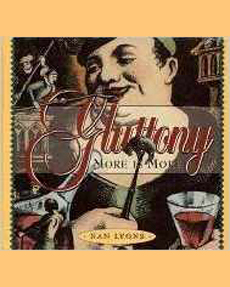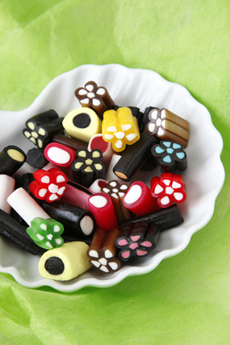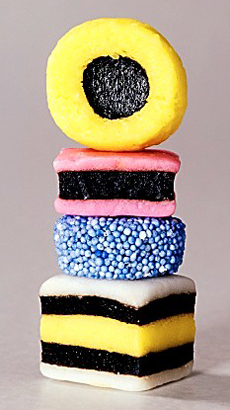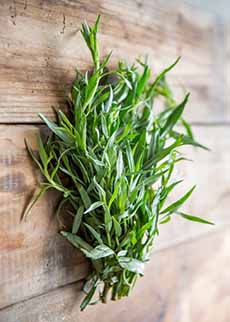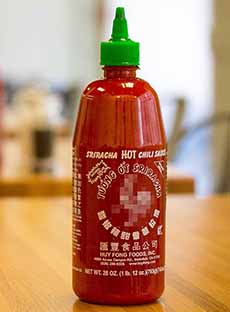
The Ataulfo, or Champagne, mango. Photo
courtesy ILoveMangoes.com. |
|
When you think of mangoes, you may think of the familiar reddish-green mangos and wonder about the petite golden-yellow ones that some people call baby mangoes.
They’re Ataulfo mangos from Mexico, also commonly called Champagne mangoes, and they’re in season now.
Mango lovers prefer them to the more prevalent Tommy Atkins cultivar (the red-green ones in the photo below). Their buttery flesh is not fibrous, and their thin pit makes them easier to slice and dice than other varieties.
The Ataulfo—it was found in a conventional mango grove owned by Mr. Ataulfo Morales—goes by several other names as well: Adaulfo, Adolfo, baby, honey, and yellow mango. It is closely related to the Alphonso variety popular in India.
See how to slice a mango, below.
|
MANGO NUTRITION
Mangoes deliver sumptuous tropical flavor with easy calories.
One cup of mango is just 100 calories, fat-free, sodium-free, and cholesterol free.
Mangos contain more than 20 different vitamins and minerals. One cup provides 100% DV of vitamin C, 35% of vitamin A, 20% of folate, 12% of fiber, and good amounts of B6, copper, K, and potassium.
Believed to be native to India, mango trees have been cultivated for more than 4,000 years. The different cultivars come in a rainbow of reds, yellows, oranges, and greens and a wide variety of shapes, flavors, textures, and aromas.
HOW TO ENJOY MANGO
Our favorite way to eat a mango is with a knife and fork, as a delicious fruit snack or dessert (note that the skin can cause stomach irritation, so should not be eaten). Second place goes to mango sorbet.
But use mango however you would use peaches or pineapples—the two fruits to which mango’s flavor is compared.
Beverages: Daiquiri, Margarita, shake with mango sorbet or ice cream, smoothie
Breads: muffins and fruit breads
Condiments: chutney and salsa
Desserts: cobbler, fruit salad, grilled fruit, ice cream or sorbet, pie, pudding, tart, tartlet
Fruit Soup: mango gazpacho
Mains: poultry, pork, seafood
Salads: green salad, shrimp salad
Recipes
Asian Fruit Salad With Pernod (recipe)
Blueberry Mango Cobbler (recipe)
Halibut With Mango-Blood Orange Salsa (recipe)
Ice Cream With Grilled Mango (recipe)
Orange Blossom Waffles With Mangoes & Nutmeg Cream (recipe)
Salmon with Cherry Mango Salsa (recipe)
Find many more recipes at ILoveMangoes.com.
|
|
HOW TO SLICE A MANGO
Peel the skin from the flesh with a small, sharp knife.
There is a long pit that runs down the center of the length of the fruit. Cut the mango lengthwise down the side of the pit to free the first half (called a cheek). Do the same with the other half.
Dice or slice the flesh as you wish.
We nibble the remaining fruit on the pit in thin slices, although it can be used in sauces or pudding.
There’s a second slicing technique that produces the “hedgehog”-like diced effect in the photo above:
Without peeling, cut the fruit from the cheeks, using the technique above.
Score the flesh into squares, about 1/2- to 3/4-inch in size, cutting up to, but not through, the skin.
|
|

The Tommy Atkins mango is the most commonly available in the U.S., due to its hardiness. Photo courtesy National Mango Board.
|
|
Gently push the mango cheek inside out, which pushes the cubes up and apart.
Cut the cubes from the skin to serve, or cut and eat cubes from a mango half with a knife and fork.
Peeled and cut fruit will hold at least three days in the fridge, in an airtight container. The flesh may darken a bit, but the flavor changes only slightly. You can tell by the aroma when the time to enjoy it has passed.
RIPENING MANGOES
Mangoes need to ripen in a warm room. To speed ripening, you can place them in a paper bag.
Color is not the best way to determine ripeness. Instead, touch and smell: A ripe mango will have a fruity aroma and the flesh will yield to gentle pressure. Unripe mangoes have no scent.
Ripe mangoes can be kept in the fridge for up to 2 weeks. The peeled flesh can be dried, frozen, puréed, or stewed.
GO FOR THE GOLD
Ataulfo mangos have only recently gained popularity in the United States, but have been a major crop in Mexico for decades. In season between March and September, they are the second-most popular variety of mango sold in the U.S., behind the Tommy Atkins cultivar.
And here’s the big tip of the day: The most prevalent mango, the Tommy Atkins, is not considered to be the choicest mango in terms of sweetness and flavor. Retailers prefer it for its very long shelf life and ability to be handled with little or no bruising, which is why it’s the mango offered first and foremost. [Source: Wikipedia]
So go for the gold: Bring home some Ataulfos and taste the difference.
The other less common mango varieties found in the U.S. include the Haden and Kent, which appear along with the Ataulfo and the Tommy Atkins in spring and summer; and the orange and green Keitt from Australia, which comes from Australia in the fall (and has a lemony note to the flesh).
Many people attest that mangoes taste best right off the tree, fresh and succulent. So if you’re in Florida, Mexico, or another mango haven, see if you can seek out the experience, called by one expert “a taste experience you’ll never forget.”
CHECK OUT WHAT’S HAPPENING ON OUR HOME PAGE, THENIBBLE.COM.
|
|





